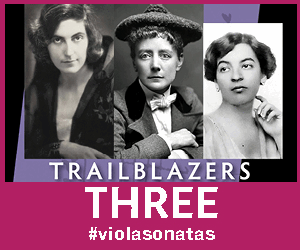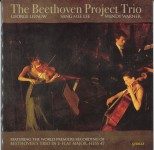 This month I had the pleasure of receiving a disc which contains two world premiere recordings of works by Beethoven. It’s not often that a new work by that Master comes to light and so my curiousity was piqued, especially since as an amateur cellist I have enjoyed working on several of his piano trios, and both of the “new” works are in that genre. The very thorough liner notes accompanying The Beethoven Project Trio CD (Çedille CDR 90000 118) explain in detail the pedigree of the pieces and why they have remained unperformed all this time. The Piano Trio in E Flat Major, Hess 47 is Beethoven’s own transcription of the first movement of his Opus 3 String Trio of 1794, thought to have been done sometime after 1800. The two-movement Piano Trio in D Major, Kinsky/Hahm Anhang 3 was originally thought to be by Mozart and catalogued by Ludwig Ritter von Köchel as Anhang 52a and thus has the distinction of being the only work by Beethoven with a Köchel number. By the 20th century however it had been recognized by scholars as an original piano trio by Beethoven dating from 1799, although its genesis is still unknown. Part of the complication of authenticating the trio is the fact that the existing manuscript is not in Beethoven’s hand, but rather in that of his younger brother Kaspar Karl who served as copyist and manager for Ludwig in his early years in Vienna. There are two pages – 33 measures – missing from that manuscript which have been re-constructed by Robert McConnell, who provides the rationale behind his choices in the notes. Undertaken in conjunction with the American Beethoven Society, the Association Beethoven France and the Beethoven-Haus Bonn, The International Beethoven Project musicians are European-trained pianist George Lepauw who is now based in Chicago, and Americans Sang Mee Lee, violin and Wendy Warner, cello. Although the concert of American premieres took place in Chicago, this excellent recording was done at the American Academy of Arts and Letters in New York City last September. The concert (and the CD) also include the American premiere of another little-known Beethoven work, the Piano Trio in E-Flat Major, Op. 63. Although it has since been acknowledged as authentic Beethoven there has been some controversy since its original publication in 1806 (according to the notes, 1807 according to my Grove’s Dictionary). It is an arrangement of the String Quintet Op. 4 of 1795, which is itself a re-working of an earlier wind octet written as dinner music for the Bishop of Bonn in 1792 before Beethoven’s move to Vienna (published posthumously in 1830). Isn’t scholarship wonderful? Suffice it to say that even though none of this is Beethoven at his best, these are welcome additions to the repertoire, immaculately performed and recorded. I look forward to the publication of the performance edition of the scores currently in production by The International Beethoven Project and promised by the end of the year. Now there’s a project for my trio to undertake next summer!
This month I had the pleasure of receiving a disc which contains two world premiere recordings of works by Beethoven. It’s not often that a new work by that Master comes to light and so my curiousity was piqued, especially since as an amateur cellist I have enjoyed working on several of his piano trios, and both of the “new” works are in that genre. The very thorough liner notes accompanying The Beethoven Project Trio CD (Çedille CDR 90000 118) explain in detail the pedigree of the pieces and why they have remained unperformed all this time. The Piano Trio in E Flat Major, Hess 47 is Beethoven’s own transcription of the first movement of his Opus 3 String Trio of 1794, thought to have been done sometime after 1800. The two-movement Piano Trio in D Major, Kinsky/Hahm Anhang 3 was originally thought to be by Mozart and catalogued by Ludwig Ritter von Köchel as Anhang 52a and thus has the distinction of being the only work by Beethoven with a Köchel number. By the 20th century however it had been recognized by scholars as an original piano trio by Beethoven dating from 1799, although its genesis is still unknown. Part of the complication of authenticating the trio is the fact that the existing manuscript is not in Beethoven’s hand, but rather in that of his younger brother Kaspar Karl who served as copyist and manager for Ludwig in his early years in Vienna. There are two pages – 33 measures – missing from that manuscript which have been re-constructed by Robert McConnell, who provides the rationale behind his choices in the notes. Undertaken in conjunction with the American Beethoven Society, the Association Beethoven France and the Beethoven-Haus Bonn, The International Beethoven Project musicians are European-trained pianist George Lepauw who is now based in Chicago, and Americans Sang Mee Lee, violin and Wendy Warner, cello. Although the concert of American premieres took place in Chicago, this excellent recording was done at the American Academy of Arts and Letters in New York City last September. The concert (and the CD) also include the American premiere of another little-known Beethoven work, the Piano Trio in E-Flat Major, Op. 63. Although it has since been acknowledged as authentic Beethoven there has been some controversy since its original publication in 1806 (according to the notes, 1807 according to my Grove’s Dictionary). It is an arrangement of the String Quintet Op. 4 of 1795, which is itself a re-working of an earlier wind octet written as dinner music for the Bishop of Bonn in 1792 before Beethoven’s move to Vienna (published posthumously in 1830). Isn’t scholarship wonderful? Suffice it to say that even though none of this is Beethoven at his best, these are welcome additions to the repertoire, immaculately performed and recorded. I look forward to the publication of the performance edition of the scores currently in production by The International Beethoven Project and promised by the end of the year. Now there’s a project for my trio to undertake next summer!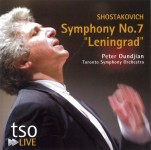 I was pleased by the thoroughness of the program notes included in the latest addition the TSO Live series (TSO-1108). Heather Slater gives us a detailed history of the origins of Symphony No.7 “Leningrad” by Dmitri Shostakovich including the original “party line” programmatic description for each of the movements and apocryphal speculation about Shostakovich’s subtexts. The booklet includes a complete list (including guest musicians) of the personnel of the Toronto Symphony Orchestra – something rarely seen in orchestral releases – in addition to the expected biography of conductor Peter Oundjian and a blurb about the orchestra. The performance, recorded in March 2008, is suitably dramatic. The signature first movement March over the snare drum ostinato begins in near silence and builds ever so gradually over the next thirteen minutes to deafening bombast before subsiding into the gentle strains of solo clarinet, bassoon and lush strings. Shostakovich we are told was aware of this section’s similarity to Ravel’s Bolero but asked to be forgiven as “this is how I hear the war”. As in Bolero the careful combination of individual instruments is like a guide to the orchestra as the tension grows and grows. The orchestra shines collectively and individually in this showcase. The thunderous applause when we reach the end of our mammoth journey nearly seventy-eight minutes later confirms this feeling as unanimous. Concert note: The Toronto Symphony will perform Shostakovich’s Fourth Symphony along with the Sibelius Violin Concerto (Henning Kraggerud, violin) and Stravinsky’s Fireworks under Jukka-Pekka Saraste October 14 & 16.
I was pleased by the thoroughness of the program notes included in the latest addition the TSO Live series (TSO-1108). Heather Slater gives us a detailed history of the origins of Symphony No.7 “Leningrad” by Dmitri Shostakovich including the original “party line” programmatic description for each of the movements and apocryphal speculation about Shostakovich’s subtexts. The booklet includes a complete list (including guest musicians) of the personnel of the Toronto Symphony Orchestra – something rarely seen in orchestral releases – in addition to the expected biography of conductor Peter Oundjian and a blurb about the orchestra. The performance, recorded in March 2008, is suitably dramatic. The signature first movement March over the snare drum ostinato begins in near silence and builds ever so gradually over the next thirteen minutes to deafening bombast before subsiding into the gentle strains of solo clarinet, bassoon and lush strings. Shostakovich we are told was aware of this section’s similarity to Ravel’s Bolero but asked to be forgiven as “this is how I hear the war”. As in Bolero the careful combination of individual instruments is like a guide to the orchestra as the tension grows and grows. The orchestra shines collectively and individually in this showcase. The thunderous applause when we reach the end of our mammoth journey nearly seventy-eight minutes later confirms this feeling as unanimous. Concert note: The Toronto Symphony will perform Shostakovich’s Fourth Symphony along with the Sibelius Violin Concerto (Henning Kraggerud, violin) and Stravinsky’s Fireworks under Jukka-Pekka Saraste October 14 & 16. 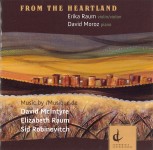 From the Heartland, the most recent addition to the Centrediscs catalogue, features works written for and performed by Toronto violinist Erika Raum, accompanied by pianist David Moroz. The disc (CMC-CD 15410) includes works by three prairie-based composers, Sid Robinovitch, David McIntyre and the violinist’s mother Elizabeth Raum. We are presented with two full fledged sonatas written for Raum very early in her career. Her mother’s sonata was composed in 1994 and premiered at Walter Hall the following year with accompanist Lydia Wong. McIntyre’s 1996 second sonata was written for Erika’s debut at the Women’s Musical Club of Toronto with pianist Francine Kay, also at Walter Hall. Both are substantial works which exploit the full range of the instruments. McIntyre’s is the lighter of the two, with a finale that begins not far from Tin Pan Alley and swings through a number of styles including a few bars reminiscent of a raucous barn dance. Elizabeth Raum is also represented by an even earlier work which Erika premiered in 1989 with the co-dedicatee Rachel Andrist. It was later revised in 1996. Robinovitch’s contribution, Dance Set #2, is a set of mostly playful dance movements – the exceptions being the Gymnopedie-like Waltz and the Processional. This is the only work presented here that was composed specifically for Raum and Moroz, for their 2003 Prairie Debut concert tour. Recorded at the Banff Centre in June 2008, around the same time that she conceived triplets with her husband composer Omar Daniel, the disc showcases Erika Raum at the top of her game. Her recent performance of Daniel’s Violin Concerto with Esprit Orchestra assures us that the burden of motherhood has not dampened her control or musical passion.
From the Heartland, the most recent addition to the Centrediscs catalogue, features works written for and performed by Toronto violinist Erika Raum, accompanied by pianist David Moroz. The disc (CMC-CD 15410) includes works by three prairie-based composers, Sid Robinovitch, David McIntyre and the violinist’s mother Elizabeth Raum. We are presented with two full fledged sonatas written for Raum very early in her career. Her mother’s sonata was composed in 1994 and premiered at Walter Hall the following year with accompanist Lydia Wong. McIntyre’s 1996 second sonata was written for Erika’s debut at the Women’s Musical Club of Toronto with pianist Francine Kay, also at Walter Hall. Both are substantial works which exploit the full range of the instruments. McIntyre’s is the lighter of the two, with a finale that begins not far from Tin Pan Alley and swings through a number of styles including a few bars reminiscent of a raucous barn dance. Elizabeth Raum is also represented by an even earlier work which Erika premiered in 1989 with the co-dedicatee Rachel Andrist. It was later revised in 1996. Robinovitch’s contribution, Dance Set #2, is a set of mostly playful dance movements – the exceptions being the Gymnopedie-like Waltz and the Processional. This is the only work presented here that was composed specifically for Raum and Moroz, for their 2003 Prairie Debut concert tour. Recorded at the Banff Centre in June 2008, around the same time that she conceived triplets with her husband composer Omar Daniel, the disc showcases Erika Raum at the top of her game. Her recent performance of Daniel’s Violin Concerto with Esprit Orchestra assures us that the burden of motherhood has not dampened her control or musical passion. 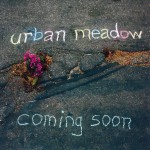 Coming Soon is a sample of what we can expect from a new local “alt jazz” label Urban Meadow. Founded by trumpeter-singer Michael Louis Johnson and clarinettist Bob Stevenson the label will provide a home for some “old timey” jazz if this collection is an accurate indication. Songs that were “a hit before your mother was born”, or at least sound like they might have been, dominate this sampler, with the exception of two more ambient, experimental tracks from composer and string wizard Monteith McCallum. Other featured artists include swing band Michael Louis Johnson and the Red Rhythm, the a cappella duo MooCow, clarinet-centric The Bob Standard, guitarist Chris Bezant, and the ensembles BIG IDEA, Safety in Numbers and RAMBUNCTIOUS. There’s no information booklet with the CD and the website (www.unbanmeadow.ca) is skeletal at the present time, but the good-time feel of the performances, variety of musical vision and good production values bode well for the future of this little label. Note: You can read Jim Galloway’s impression of Urban Meadow’s first full release “Saturday Matinee” (um201001) by Michael Louis Johnson and The Red Rhythm in this month’s Jazz reviews.
Coming Soon is a sample of what we can expect from a new local “alt jazz” label Urban Meadow. Founded by trumpeter-singer Michael Louis Johnson and clarinettist Bob Stevenson the label will provide a home for some “old timey” jazz if this collection is an accurate indication. Songs that were “a hit before your mother was born”, or at least sound like they might have been, dominate this sampler, with the exception of two more ambient, experimental tracks from composer and string wizard Monteith McCallum. Other featured artists include swing band Michael Louis Johnson and the Red Rhythm, the a cappella duo MooCow, clarinet-centric The Bob Standard, guitarist Chris Bezant, and the ensembles BIG IDEA, Safety in Numbers and RAMBUNCTIOUS. There’s no information booklet with the CD and the website (www.unbanmeadow.ca) is skeletal at the present time, but the good-time feel of the performances, variety of musical vision and good production values bode well for the future of this little label. Note: You can read Jim Galloway’s impression of Urban Meadow’s first full release “Saturday Matinee” (um201001) by Michael Louis Johnson and The Red Rhythm in this month’s Jazz reviews.
We welcome your feedback and invite submissions. CDs and comments should be sent to: The WholeNote, 503 – 720 Bathurst St. Toronto ON M5S 2R4. We also encourage you to visit our website, www.thewholenote.com, where you can find added features including direct links to performers, composers and record labels, “buy buttons” for on-line shopping and additional, expanded and archival reviews.
David Olds
DISCoveries Editor
discoveries@thewholenote.com



